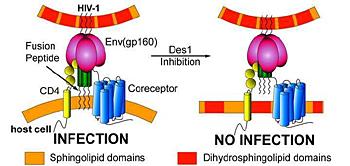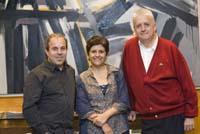Coraza cells to protect against AIDS
According to an article published today in the journal Chemistry Biology, an investigation led by Félix Goñi, director of the Biophysics Unit, has developed a new way to protect cells against HIV. According to their words, they have managed to "dress a shell at the cells."
In fact, researchers have been based on the obstruction of the HIV cellular penetration strategy. In principle, HIV does not enter cells from anywhere, but enters through a specific area of the membrane, the sphingolipid zone. The researchers have focused on it and studied how to protect this space.
Thus, it has been shown that the area is governed by the inhibition of the enzyme that introduces double binding in sphingolipids. Sphingolipidia are replaced by dihydrosphingolipids which by rigidification cannot fuse the membrane of HIV and the cell. Therefore, HIV cannot infect the cell. For this reason, researchers have said that the cell has been "coraza".

On the right you can see how HIV fuses with the cell's inlet membrane. On the left, after the inhibition of the DES1 gene, the area where the fusion occurs looks rigid (in red instead of in orange), so it cannot be merged. (Photo: Biophysics Unit)
In the words of Félix Goñi, the rigidity does not affect the functionality of the cell. Goñi has explained that they can inhibit the enzyme in two ways: "by means of a molecule developed by one of the groups participating in the research, or by inactivating the gene corresponding to the enzyme through RNA inhibitors." This gene is DES1.
Result of three years of collaboration
In addition to the team of the Biophysics Unit, a joint centre between CSIC and UPV-EHU, the Spanish Centre for Biotechnology (CSIC, Autonomous University of Madrid) and the Institute of Applied Chemistry of Catalonia (CSIC, Barcelona) participated in the research. "The research has lasted three years," says Goñi. "It's not long, but we have to keep in mind that we're all investigating in this field for a long time. In addition, the first two years have been hard, because we did not achieve good results. The achievements have reached the end."

In the image, from left to right, Santos Mañes, Gemma Fabrias and Felix Goñi. (Photo: Biophysics Unit)
Yesterday the news was released and today the results have been published in the prestigious journal Chemistry Biology of the group Cell. The article highlights that, in the first place, they have shown that dihydrosphingolipids form rigid zones in the membranes of the type cells, that the inhibition of DES1 increases the dihydrosphingolipids in the membranes of the living cells, that the GIB-1 prevents the infection of the cell through the chemical or genetic block of the activity DES1 and, finally, that the hydrosphingolithic tendencies are fused.
In any case, Felix Goñi has warned that "it will take" to apply to therapy: "To achieve this we still have to do a lot of work and first we need someone to fund research." For the moment, they have no money, but it is noted that they do not lack the desire to work.
Buletina
Bidali zure helbide elektronikoa eta jaso asteroko buletina zure sarrera-ontzian











